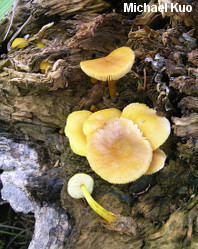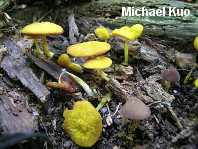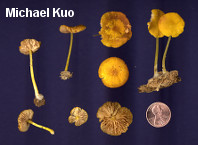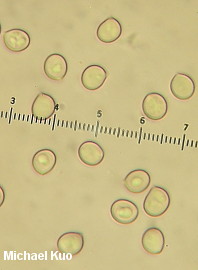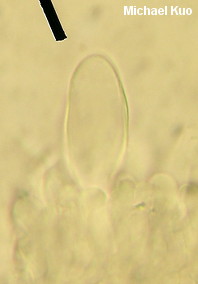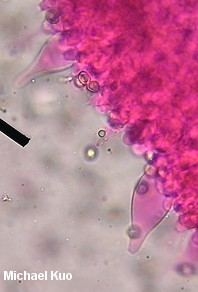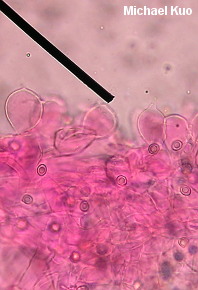| Major Groups > Gilled Mushrooms > Pink-Spored > Pluteus > Pluteus chrysophlebius |

|
Pluteus chrysophlebius [ Basidiomycota > Agaricales > Pluteaceae > Pluteus . . . ] by Michael Kuo For those of us who live in areas where finding a Pluteus usually means finding a boring, brown mushroom, Pluteus chrysophlebius is a welcome sight, quite admirably holding up the not-boring side of the genus. It is recognized as a Pluteus by its pinkish mature gills and spore print, its habitat on rotting wood, and its lack of a volva--and among species of Pluteus, it is distinguished by its bright yellow cap and stem, and its bald cap texture. Although it is widely distributed in North America, it is uncommon from the Rocky Mountains westward. North American collections of this species have often been labeled "Pluteus admirabilis" or "Pluteus chrysophaeus." But recent studies (Minnis & Sundberg, 2010; Justo and collaborators, 2011) support the idea that Pluteus admirabilis, named from New York in the late 19th Century, is actually the same species as Pluteus chrysophlebius, named from South Carolina in 1859. The Justo study recommends abandoning the name chrysophaeus altogether, since the original, 18th-Century illustration of the species indicates a mushroom with a brown, rather than yellow, cap. However, I have found (very rarely) Pluteus chrysophlebius populations with brown caps and yellow caps arising together (see the illustration), perhaps indicating that the chrysophaeus question may be worth further investigation. Pluteus melleus, Pluteus rugosidiscus, and Pluteus admirabilis are synonyms. Description: Ecology: Saprobic on the deadwood of hardwoods or, more rarely, conifers; causing a white rot; growing alone or gregariously on stumps and logs; late spring through early fall; widely distributed in North America, but much more common east of the Rocky Mountains. The illustrated and described collections are from Illinois, Wisconsin, and Colorado. Cap: 1-2.5 cm; broadly conic when young, becoming broadly convex to flat, sometimes with a central bump; moist; bald; when young sometimes centrally wrinkled or veined; the margin sometimes finely lined; bright yellow when young, dull yellow or brownish yellow in age. Gills: Free from the stem; close or crowded; short-gills frequent; whitish at first, becoming pinkish. Stem: 2-5 cm long; 1-3 mm thick; equal; fragile; bald; pale yellow; basal mycelium white. Flesh: Insubstantial; yellowish. Odor and Taste: Odor somewhat bleachlike when crushed; taste similar, or not distinctive. Spore Print: Pink. Microscopic Features: Spores 5-7 x 4.5-6 µ; subglobose to widely ellipsoid or sublacrymoid; smooth; hyaline in KOH; inamyloid. Pleurocystidia widely lageniform, with or without an extended neck; 30-60 x 10-20 µ; thick-walled; hyaline in KOH. Cheilocystidia similar to pleurocystidia, or more or less clavate. Pileipellis hymeniform; elements hyaline to yellowish in KOH. REFERENCES: (Berkeley & Curtis, 1859) Saccardo, 1887. (Peck, 1872; Kauffman, 1918; Singer, 1956; Homola, 1972; Smith, Smith & Weber, 1979; Phillips, 1991/2005; Lincoff, 1992; Horn, Kay & Abel, 1993; Barron, 1999; McNeil, 2006; Miller & Miller, 2006; Minnis & Sundberg, 2010; Justo et al., 2011; Kuo & Methven, 2014.) Herb. Kuo 06150304, 07100303, 06040401, 08150709. This site contains no information about the edibility or toxicity of mushrooms. |
© MushroomExpert.Com |
|
Cite this page as: Kuo, M. (2015, May). Pluteus chrysophlebius. Retrieved from the MushroomExpert.Com Web site: http://www.mushroomexpert.com/pluteus_chrysophlebius.html |
